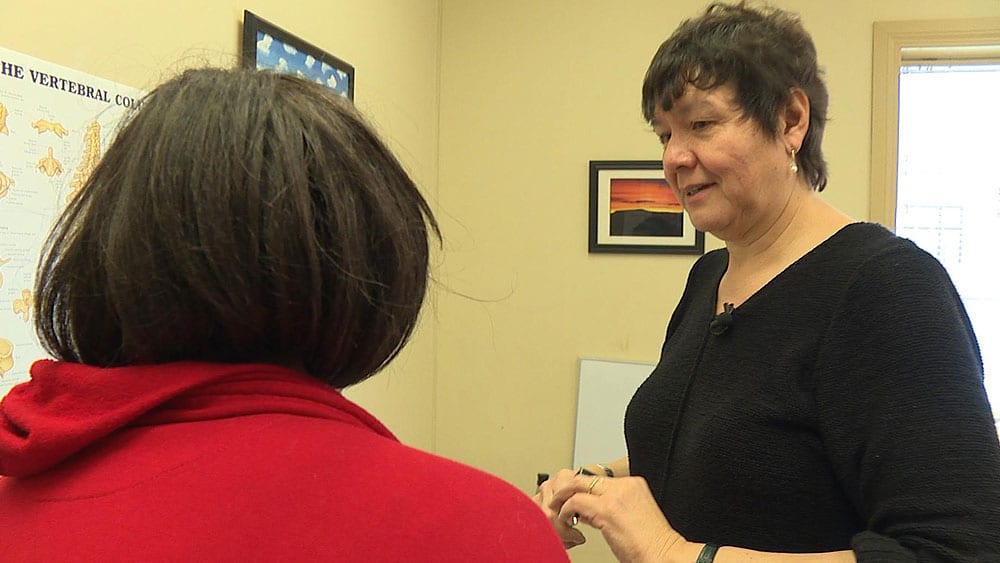
Alberta Legislature. Photo: Danielle Paradis/APTN
Between 2015 and 2021 the life expectancy dropped a shocking seven years for First Nations men and women living in Alberta due in part to drug poisoning deaths.
In 2015, the average life expectancy for a First Nation man was 67 – today that has dropped to 60. For First Nations women, it’s gone from 73 in 2015 to 66 years in 2021.
The life expectancy of a non-First Nations man is 79. For non-First Nations women it is 84.
According to data from First Nation’s health statistics from the Alberta First Nations Information Governance Centre, the rate of opioid poisoning deaths is seven times higher for First Nations people compared to non-First Nations people.
“The province seems oblivious to the challenges that Indigenous people are facing and they are not ready to open their eyes. It is just a nightmare,” said Dr. Esther Tailfeathers who has recently resigned as the medical lead at Alberta Health Service’s (AHS) Indigenous Wellness Core.
“You see that in 2019 there’s a stark increase in mortality and it is also when the UCP introduces the recovery-oriented systems, which skips over harm reduction in hopes that people can just get through withdrawal and get themselves to treatment,” said Tailfeathers.
APTN News asked both Alberta Health and the Métis Nation of Alberta for data on Métis people but they were unable to provide data.
Tailfeathers told APTN that opioid deaths are a significant factor in lowering the overall life expectancy for First Nations people.
“There’s a parallel increase in the overdose deaths of First Nations versus non-First Nations people when you look at the statistics there’s a significant change in 2019 when the mortality rate raises significantly from the trajectory of the non-First Nations one,” said Tailfeathers.
In other words, the drop in life expectancy is at least in part due to an increase in opioid poisonings.
First Nations male and female life expectancy in Alberta is well below the Canadian average of 82.6 years.
For First Nations men, a life expectancy of 60 aligns with the life expectancy of men in countries like Haiti and Bolivia. Both of which have a much lower GDP than Canada.
A country having a higher GDP is associated with an increased life expectancy.
Comments from Alberta Health confirm that there is a correlation between drug poisoning and the gap in life expectancy.
“[P]reliminary investigations suggest that deaths related to substance misuse among those 20-40 years of age may be a key driver of the gap in life expectancy,” said Charity Wallace, the assistant director of communications for Alberta Health.
The government’s most recent opioid poisoning surveillance report from June 2023 doesn’t differentiate between First Nations and non-First Nations people.
The last report that was specific to First Nations is from June 2021. The latest data on First Nations drug and alcohol-related deaths has not been released.
Tailfeathers spoke to APTN the day after presenting information on opioid poisoning and addiction issues to Chiefs from Treaty 6, 7, and 8.
Tailfeathers resigned from the Indigenous Wellness Core - a program that works to provide culturally appropriate health services for First Nations, Inuit and Métis people.
It came after the province’s former chief medical officer of health, Deena Hinshaw, was hired to work with Tailfeathers and her colleagues at the program.
Hinshaw spearheaded Alberta’s response to the COVID-19 pandemic. By the end of her term, she was not popular with the public.
When it became known that she was hired for the Indigenous wellness program, the offer was revoked.
“I saw the obstruction and how non-genuine people were into actually making a difference in the mortality rate of Indigenous people in this province,” said Tailfeathers about her time working with the province.
"What they think is best for us is still happening the way the old Indian agents decided what was best for us," said Tailfeathers.
During the first six months of 2020 the city of Lethbridge had one of the highest rates of opioid overdose deaths among First Nations and non-First Nations people in the province.
In August 2020, the province pulled funding for the city’s safe consumption site.
After complaints from the community and a financial audit which found a “misuse of government funding and inappropriate governance” in Lethbridge the supervised consumption site, which was the busiest in the province, closed.
According to the Alberta opioid response surveillance report for First Nations people released June 2021, compared to non-First Nations people, there was a spike in deaths after the centre closed.
“It is all very UCP, conservative thinking that the best thing to do is to remove the resources from the people and let them die,” said Tailfeathers.
In October 2022, the former minister for mental health and addictions Mike Ellis said in a press release that, “the steady decline in opioid deaths in Alberta is a positive sign and we are optimistic it will continue.”
But the data now shows that the statement from the minister is not supported by the numbers.
The recent data shows an increase in overdose deaths. Alberta lost a record 179 people to drug poisoning in April 2023.
By comparison, In April 2022 the number of drug poisionings was at 108.
Death by drug poisioning is occurring most frequently in the 25-30 and 35-40 age groups.
The minister of mental health and addiction recovery Dan Williams was sworn in on June 9, 2023.
“Alberta’s model of recovery is becoming a leader in addiction treatment throughout North America. Many pieces of this model include initiatives such as supervised consumption sites, distribution of naloxone kits, as well as providing sterile supplies.
“These are important parts of our plan to help individuals move into the next steps of long-term recovery from addiction,” said Hunter Baril press secretary for the minister of mental health and addiction in response to questions from APTN about whether they plan on continuing to focus more on recovery-focused care rather than harm-reduction.
Read More:
Enoch Cree Nation gets $30M for new drug treatment centre
APTN reached out to former chief Billy Morin from Enoch Cree Nation who serves as a special advisor to the premier on Indigenous relations and is a part of the public safety and community response task force for comment on whether he supports additional harm reduction measures but our inquiry went unanswered.

The Blood Tribe/Kainai Nation, where Tailfeathers is a member, was among the first to raise the alarm about fentanyl in Canada. It was also among the first to take action. It declared a state of emergency in March 2015 after 20 overdose deaths and 60 non-fatal overdoses in a six-month period.
They declared another state of emergency in both April and May of 2023.
“There is a very poisonous batch of drugs within the southern Alberta region which has the potential to lead to a spike of drug poisonings in our community,” said a notice sent out by Blood Tribe communications in May.
This is not a problem that is specific to one nation.
"This has probably been the worst time ever for the number of deaths that the chiefs are dealing with in their communities. So mental health and addictions is a priority for them," said Tailfeathers.
The rate of emergency department visits related to opioids and “substances of misuse” were six times higher than the non-First Nations population.
The same report also shows that the rate of opioid dispensing from community pharmacies to First Nations people is two times higher.










